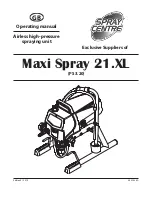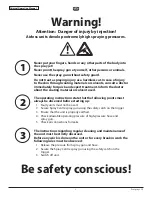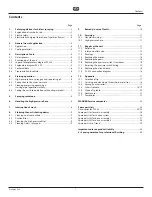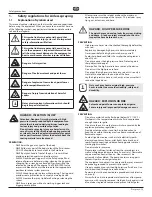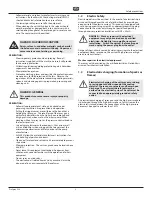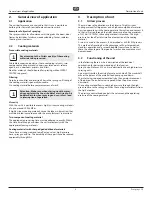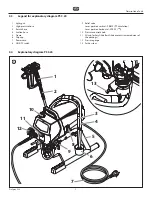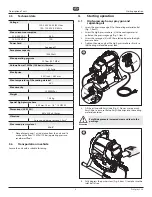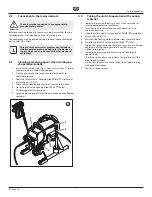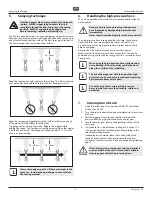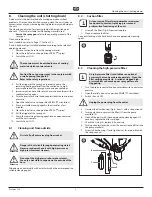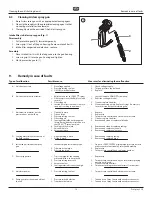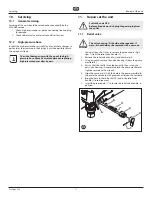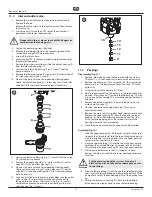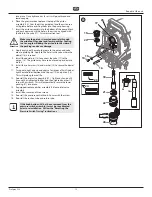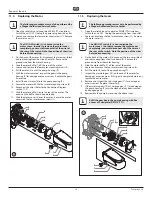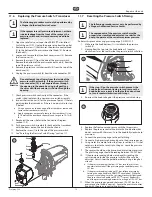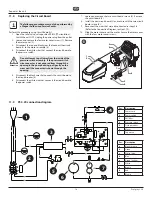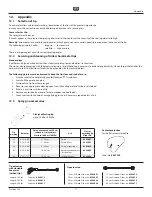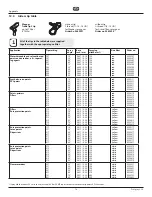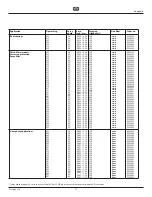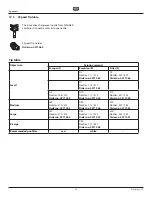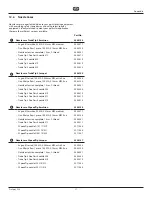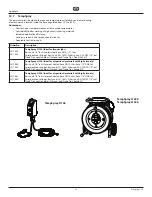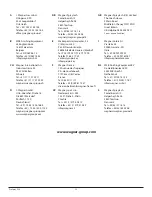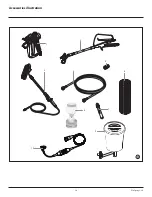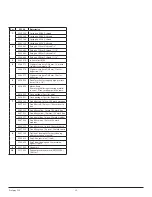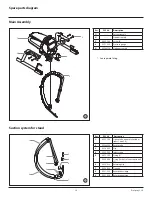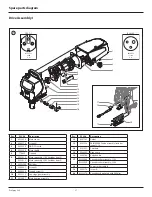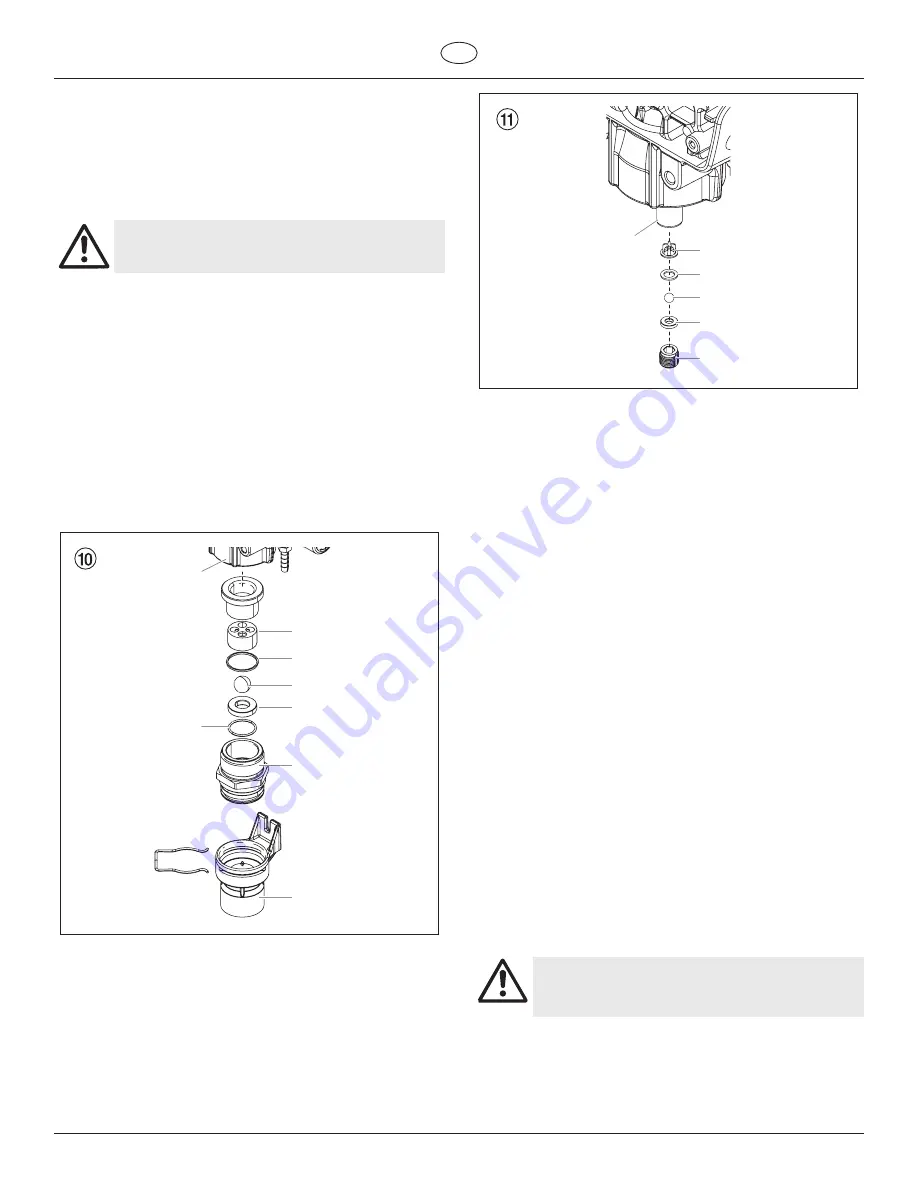
12
ProSpray 3.20
GB
Repairs at the unit
11.2 Inlet and outlet valve
1. Remove the screw that secures the pressure control knob.
Remove the knob.
Remove the three screws in the front cover and then remove
the front cover.
2. Switch the unit ON and then OFF so that the piston rod is
positioned in the lower stroke position.
Danger of crushing - do not reach with the fingers or
tool between the moving parts.
3. Unplug the power plug from the outlet.
4. Remove the retaining clip from the connecting bend at the
suction hose and pull off the suction hose.
5. Screw off the return hose.
6. Swivel the unit 90° to the rear in order to work more easily on
the material feed pump.
7. Remove the pusher stem clip and slide the pusher housing (7)
from the inlet valve housing (1).
8. Unscrew the inlet valve housing (Fig. 10, Item 1) from the
pump manifold (2).
9. Remove the lower ball guide (6), lower seal (5), inlet valve ball
(4), inlet valve seat (3) and O-ring (8).
10. Clean all the parts with the corresponding cleaning agent.
Check the inlet valve housing (1), inlet valve seat (3) and inlet
valve ball (4) for wear and replace the parts if necessary.
1
3
4
5
6
7
2
8
11. Unscrew outlet valve housing (Fig. 11, Item 9) from the piston
(10) with adjusting wrench.
12. Remove the upper ball guide (14), crush washer (13), outlet
valve ball (12), and outlet valve seat (11).
13. Clean all the parts with the corresponding cleaning agent.
Check outlet valve housing (9), outlet valve seat (11), outlet
valve ball (12) and upper ball guide (14) for wear and replace
parts if necessary.
14. Carry out installation in the reverse order. Make sure the outlet
valve retainer (9) is reinstalled with the non-threaded “lip”
facing up into the piston. Lubricate O-ring (Fig. 10, Item 8)
with machine grease and ensure proper seating in the inlet
valve housing (Fig. 10, Item 1).
14
10
9
11
12
13
11.3 Packings
Disassembly (Fig. 12)
1. Remove inlet valve housing in accordance with the steps in
Chapter 11.2. It is not necessary to remove the outlet valve.
2. Remove the yoke screw (14) and washer (15) that secures the
dowel pin (16). The dowel pin connects the yoke (17) to the
piston (18).
3. Using a pliers, pull the dowel pin (16) out.
4. Rotate the pump shaft so the piston is in the top dead center
position. Press the yoke (17) against the top bushing (19) with
a screwdriver, for example. This is required to disassemble all
the parts.
5. Remove the piston assembly (18) by pushing down on the
piston near the yoke (17).
6. Unscrew and remove the upper bushing (19) using an
adjustable wrench.
7. Remove the worn seals using a flat head screwdriver or punch.
Remove the upper packing (20) from the top and the lower
packing (21) from the bottom by pressing against the side
of the seal and popping it out. Be sure not to scratch the
housing where the seals are located.
8. Clean the area where the new packings are to be installed.
Assembly (Fig. 12)
1. Slide the upper packing (20) off the grey sizing/insertion tool
(towards the tip) and install into the top of the pump housing
with the raised lip (23) facing down. Save the upper packing
sizing/insertion tool for use in step 6.
2. Place the upper bushing (19) into the top of the housing and
tighten with an adjustable wrench (torque to 300-360 in-lbs).
This will drive the upper packing (20) into the correct position.
3. Tilt the pump backwards so that it is laying on its back.
Remove the plastic wrap from the lower packing and red pre-
form tool.
Attention
Cut the plastic wrap with a scissors. Do not cut
plastic wrap with a utility knife as damage can occur
to the O-rings.
4. Slide the lower packing (21) off the pre-form tool (towards the
top). Insert the lower packing partially into the bottom of the
pump block so that the beveled edge (24) of the packing faces
up.
5. Thread the inlet valve housing (22) back into the bottom
of the pump housing by hand to drive the lower packing

